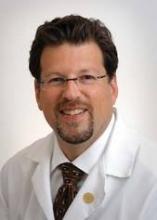A new multisociety sedation curriculum for gastrointestinal endoscopy spells out the essential elements of procedural sedation and should be useful to fellows and established practitioners alike. The complete curriculum was published in the July 2012 issue of Gastroenterology.
"It came to the attention of many practitioners, educators, and researchers that we needed to develop a standardized, competency-based curriculum for procedural sedation," Dr. John J. Vargo, committee chair and editor of the curriculum and one of the team of contributing experts, said in an interview. Such a curriculum would house all facets of procedural sedation, including patient assessment, pharmacology of relevant agents, and patient recovery parameters, in one core document, he explained.
"Ideally, we will be giving our fellows and their mentors a competency-based training platform for procedural sedation," he said.
The curriculum also provides practicing clinicians with an opportunity to review the information and identify areas in their procedural sedation practices that might need updating, noted Dr. Vargo. "Medicine is now a journey of continuous education and training, and this is a document that could serve established practitioners in that vein," he said.
"Sedation is a necessary core component for safe and effective performance of GI endoscopic procedures," said Dr. David R. Lichtenstein of Boston University, who was not involved in writing the curriculum.
In an interview, Dr. Lichtenstein noted that "Sedation is intended primarily to reduce our patients’ anxiety and discomfort, resulting in improved tolerability and satisfaction for the procedure."
However, use of sedation has both pros and cons, he said. "Sedation delays patient recovery and discharge, increases the risk of cardiopulmonary complications, and adds to the overall cost of the endoscopic procedure."
The curriculum, known as the Multisociety Sedation Curriculum for Gastrointestinal Endoscopy (MSCGE), is a joint effort of the American Association for the Study of Liver Diseases, the American College of Gastroenterology, the AGA Institute, and the American Society for Gastrointestinal Endoscopy. The Society for Gastroenterology Nurses and Associates also was involved in developing the curriculum, which was published simultaneously in Gastroenterology, the American Journal of Gastroenterology, Gastrointestinal Endoscopy, and Hepatology, and on the website of the Society of Gastroenterology Nurses and Associates (Gastroenterology 2012;143:e18-e41).
The sponsoring societies divided the curriculum into 11 sections: sedation pharmacology; informed consent for endoscopic sedation; periprocedure assessment for endoscopic procedures, levels of sedation; training in the administration of specific agents for moderate sedation; training in airway/rescue techniques and management of complications; anesthesiologist assistance for endoscopic procedures; intraprocedure monitoring; post-procedure assessment training; endoscopy in pregnant and lactating women; and an assessment of competency in endoscopic sedation.
The curriculum "serves as the societies’ vision of best practices in procedural sedation based on evidence-based publications and expert opinion," said Dr. Lichtenstein. "For the practicing gastroenterologist, the MSCGE can serve to validate an existing knowledge base and skill set while providing a curriculum to update deficiencies that may exist. For those individuals in training, the document serves as a reference [for] both the trainee and mentor, ensuring that the goals of training and assessment of competency have been achieved," he said.
Although some patients can undergo endoscopic procedures without sedation, most of these procedures in the United States do involve sedation and anesthesia, Dr. Lichtenstein said.
The curriculum attempts to address some of the challenges in endoscopic sedation. "The most difficult challenge facing our profession resides in the tailoring of the level of sedation to the individual patient and procedure, and selecting the most appropriate provider to deliver the sedation in an environment focused on optimizing patient safety [and] satisfaction, while maintaining fiscal responsibility," he said.
Despite these challenges, "the use of sedation during endoscopy and in particular the use of anesthesiologists and nurse anesthetists during routine ‘low risk’ gastrointestinal endoscopy continues to increase throughout the world," Dr. Lichtenstein noted. "Use of anesthesia services offers the opportunity for deeper sedation or general anesthesia requiring increased physiological monitoring and additional skills for airway management when compared with the lighter ‘moderate sedation’ typically provided by nurses under the direct supervision of the endoscopist," he said.
What does the future hold for endoscopic sedation? A key question is whether anesthesia services should be offered only to patients with absolute need, based on high- risk profiles, Dr. Lichtenstein said. Some examples of high-risk patients include those predicted to have a suboptimal response to sedation because of underlying substance abuse or those with a high-risk airway, he noted.
"We must demonstrate added value for our patients to justify the utilization of anesthesia services for our low-risk patients," he said. Questions to address in clinical practice include the following, he added: Are patients more satisfied? Are patients more likely to return for surveillance exam? Can patients recover faster and return to their preprocedure level of activity earlier? Can we increase efficiency in our endoscopy units? Is gastroenterologist-directed propofol administration off the table permanently or can we reintroduce this practice with appropriate training as outlined in prior societal guidelines?


